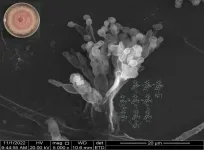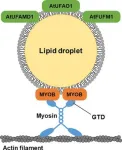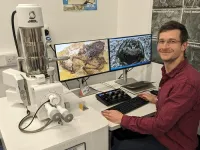Molecular mechanism of chemical diversity of thermophilic fungus and its ecological and biological functions
2024-04-23
(Press-News.org)
Thermophilic fungi are chief components of mycoflora in a variety of natural and manmade composting systems, including rotting hay, stored grains, wood mulch, nesting material of birds and animals, municipal refuse, and self-heating accumulated organic matter. Thermophilic fungi are also a potential source of natural products, which complement the metabolite libraries of mesophilic fungi and bacteria.
The research team led by Prof. Dr. Xuemei Niu (State Key Laboratory for Conservation and Utilization of Bio-Resources in Yunnan, Yunnan University) has been working on the discovery of secondary metabolites in thermophilic fungi and their biological activities and natural functions since 2007. In early 2010, the team reported that a predominant thermophilic fungus Thermomyces dupontii produced a new class of prenylated indole alkaloids (PIAs), bearing the striking structural features of a key putative versatile precursor that has long been proposed for the well-known complex PIAs in mesophilic fungi.
In this study, the team sought to determine why T. dupontii produced such a class of PIAs. They aimed at two P450 genes in the gene cluster responsible for PIAs, because P450 can modify and transform secondary metabolites to generate diverse and complex metabolites. What’s more, the ecological importance of P450 genes remains poorly understood up to date. Unexpectedly, bioinformatics analysis indicated that one of the P450 genes is a unique fusion gene P450L that encodes two functional domains that were separately encoded by two independent genes in other fungi.
They established a thermophilic CRISPR/Cas9 system and constructed two mutant deficiencies in two P450 genes. The team performed metabolic analysis and detailed chemical investigation and found that two P450 genes have multifunctions in forming simple PIA-derived iron chelators, bolstering simple PIAs to complex PIAs, and yielding effective iron chelators. Surprisingly, they observed that the fusion gene P450L has an additional role in the formation of more complex iron chelators derived from new complex PIAs.
The researchers also evaluated the iron levels in the mutants and found that the P450-mediated metabolite modifications were involved in elevating Fe2+ levels but attenuating Fe3+ levels, thus leading to high ratios of Fe2+/Fe3+ in the thermophilic fungus under cold stress, which regulated mitochondrial contents and lipid formation in mycelia and contributed to strong and stout conidiophores, thereby facilitating thermophilic fungal conidial survival under cold stress.
As one of the basic and limiting physical factors in the environment, temperature plays a very important and even decisive role in the survival and distribution of organisms on the Earth's surface. With the intensification of global extreme climate change, the research on adaptation and combating temperature change has attracted more and more attention. The new exciting results in this study might explain why Thermomyces species with a large reduced genome can survive in the biosphere where temperatures are often below their growth temperatures. They suggest the fungus does not need many biosynthetic core genes for distinct families of metabolites, P450-mediated structural modifications can meet the needs of fungal low-temperature tolerance and survival ability.
“This study will encourage scientists working on structural diversity to discover the natural functions of modifying genes and to reveal all the unknown molecular secrets that the chemical diversity has,” Prof. Dr. Xuemei Niu said.
See the article:
Gene Fusion and Functional Diversification of P450 Genes Facilitate Thermophilic Fungal Adaptation to Temperature Change
https://www.tandfonline.com/doi/full/10.1080/21501203.2024.2324993
END
[Attachments] See images for this press release:


ELSE PRESS RELEASES FROM THIS DATE:
2024-04-23
DALLAS, April 23, 2024 — Atrial fibrillation, or AFib, is the most common type of irregular heartbeat, estimated to affect about 12.1 million U.S. adults by 2030.[1] The abnormal firing of electrical impulses causes part of the heart to quiver, or fibrillate, often leading to complications and up to a fivefold increased risk of stroke. To help ensure all patients with AFib receive the most appropriate care, the American Heart Association is launching a new effort to educate and engage pharmacists, an important but underrepresented voice in AFib care.
This ...
2024-04-23
We experience the world and connect with others through social interactions. Engaging in activities, such as conversations, cooperative tasks, and intimate relationships, deeply affect brain activity leading to coordinated neural activity within an individual's brain (intra-brain synchronization) and between the brains of multiple individuals (inter-brain synchronization).
Researchers study brain synchronizations to understand the neural processes behind social behaviors. This knowledge can help diagnose and treat conditions like social anxiety and communication-related disorders. However, investigations on brain synchronization ...
2024-04-23
Lipids are biomolecules essential for the proper functioning of the living cell, ranging from comprising cell membranes to forming integral components of cell signaling pathways. Plant cells possess cell subcellular structures or organelles called lipid droplets (LDs) in the leaves and seeds, which store excess lipids (fats).
Recent studies have shown that LDs also localize unique plant proteins that perform essential molecular functions. For example, seed LDs localize plant proteins called oleosins, which help seeds weather freezing temperatures and germinate properly. With an expanding body of proof ...
2024-04-23
NEW YORK, April 23, 2024 — Single-photon emitters (SPEs) are akin to microscopic lightbulbs that emit only one photon (a quantum of light) at a time. These tiny structures hold immense importance for the development of quantum technology, particularly in applications such as secure communications and high-resolution imaging. However, many materials that contain SPEs are impractical for use in mass manufacturing due to their high cost and the difficulty of integrating them into complex devices.
In 2015, scientists discovered SPEs within a material called hexagonal boron nitride (hBN). Since then, hBN has gained widespread attention and ...
2024-04-23
Palaeontologists at University College Cork (UCC), Ireland, have solved a hundred-year-old mystery of how some fossil frogs preserve their fleshy parts – it’s all down to their skin.
Palaeontologists Daniel Falk and Prof. Maria McNamara, together with scientists from Ireland, Germany and the UK, studied 45-million-year-old fossil frogs from the Geiseltal site in central Germany. Remarkably, the fossils show full body outlines of the soft tissues. The team discovered that the excellent condition of the fossil frogs is due to preservation of ancient skin remnants.
The team studied the fossils with high-precision ...
2024-04-23
Existing drugs studied in patients with rare immune diseases
This month the first study within the DRIMID consortium (DRIMID stands for Drug Rediscovery for Rare Immune Mediated Inflammatory Diseases) has started. This study will investigate the efficacy and safety of the drug filgotinib (approved for treatment of rheumatoid arthritis and ulcerative colitis) in three rare immune diseases (Behçet's disease, idiopathic inflammatory myositis, IgG4-related disease). DRIMID aims to investigate whether this drug - despite the absence of formal ...
2024-04-23
A new study conducted by researchers at Loma Linda University Children’s Health has shed light on the alarming rates of pediatric injuries resulting from mechanical bull riding. The study, titled "Mechanical Bull Injuries in Pediatric Patients: A Call for Safety Regulations," highlights the urgent need for enhanced safety measures and regulations.
The findings were published in the journal Children's Health Care and revealed that mechanical bull riding poses a significant risk to children, with traumatic brain injuries being the most common outcome.
“Mechanical bulls, even when ...
2024-04-23
ROCKVILLE, Md.— Compared to their civilian counterparts, excessive pregnancy weight gain is more frequent among military health care beneficiaries, in particular active duty personnel, and is associated with costly maternal/neonatal complications. Women in this sample with excessive pregnancy weight gain were also three times more likely to have substantial postpartum weight retention, according to a new study published in the journal Obesity, The Obesity Society’s (TOS) flagship journal.
Substantial weight retention ...
2024-04-23
Body odor from the armpits comes from bacteria metabolizing sweat produced by the apocrine glands. These bacteria are native to our skin, but the odors produced differ among people. Generally, people use deodorants on their armpits, but perhaps there is a way to get rid of the bacteria.
To find out, a research team led by Osaka Metropolitan University Professor Satoshi Uematsu and Associate Professor Kosuke Fujimoto at the Graduate School of Medicine collected body fluid samples from the armpits of 20 men that were deemed healthy. In advance, a subjective olfactory panel classified ...
2024-04-23
When it comes to matters of the heart, cardiovascular disease in women is underdiagnosed compared to men. A popular scoring system used to estimate how likely a person is to develop a cardiovascular disease within the next 10 years is the Framingham Risk Score. It is based on factors including age, sex, cholesterol levels, and blood pressure.
Researchers in the US and the Netherlands have now used a large dataset to build more accurate cardiovascular risk models than the Framingham Risk Score. They also quantified the underdiagnosis of women compared to men. The results were published in Frontiers ...
LAST 30 PRESS RELEASES:
[Press-News.org] Molecular mechanism of chemical diversity of thermophilic fungus and its ecological and biological functions







